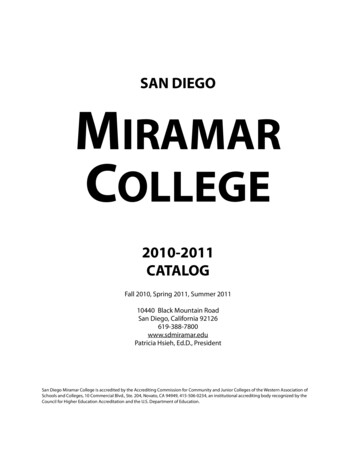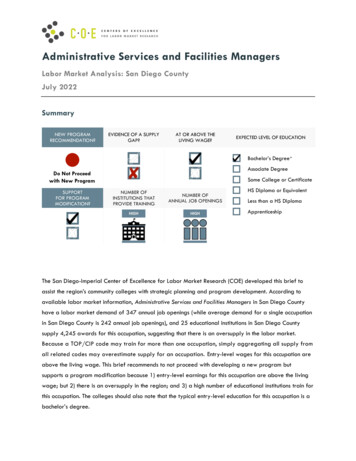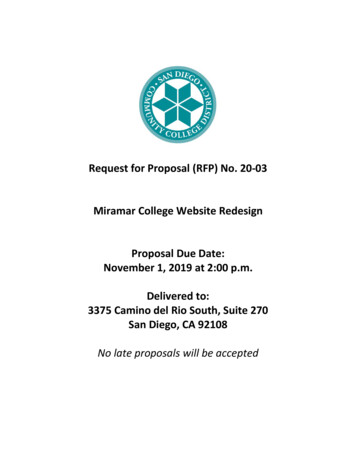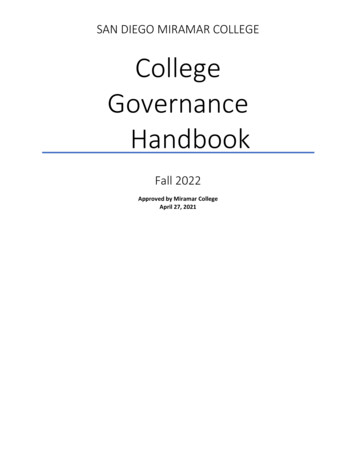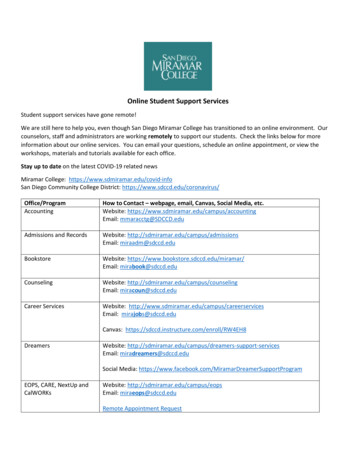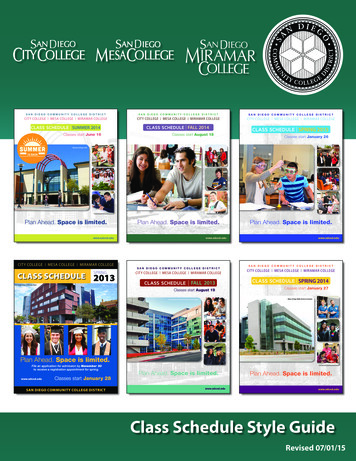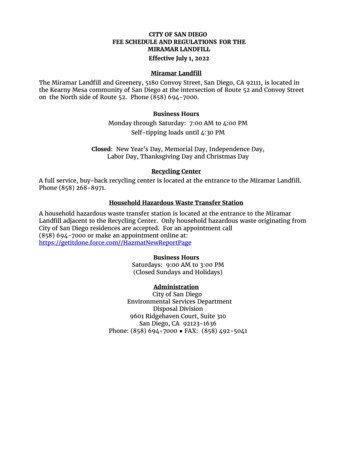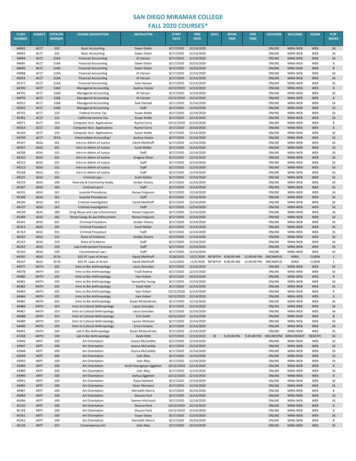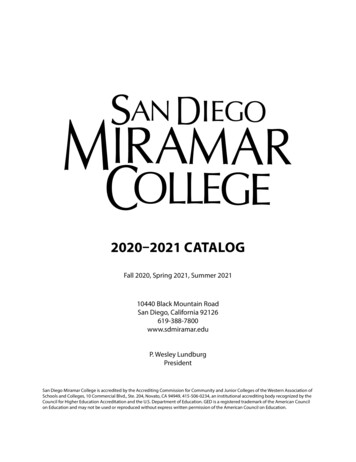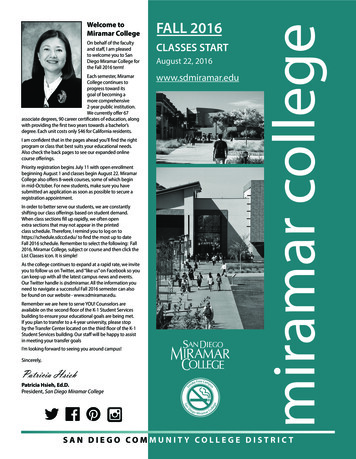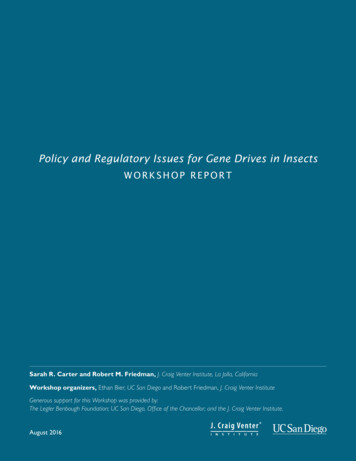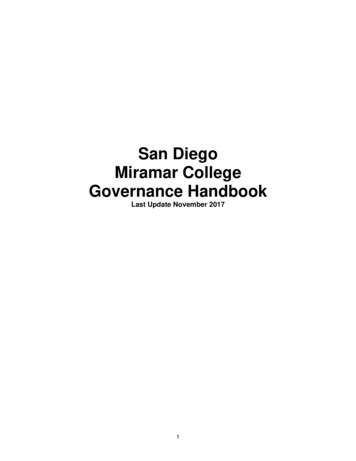
Transcription
San DiegoMiramar CollegeGovernance HandbookLast Update November 20171
SUMMARY OF CEC APPROVED CHANGES TO THE COLLEGE GOVERNANCE HANDBOOK(As of November 30, 2017)1. Student Services Committee Revise committee goals and proceduresRevise committee membershipDissolve Commencement Subcommittee2. Professional Advancement Committee Added Student Services faculty memberRemoved Goal #33. Professional Development Committee Create Professional Development CommitteeDissolve Staff Development Committee4. Basic Skills Subcommittee Changed language to reflect changes to college structure (e.g. PLACe to Academic Success Center)2
Table of ContentsPreamble . 4Mission . 4Guiding Principles . 4Overall Structure . 6Committee Membership and Goals . 7College Executive Committee (CEC) . 8Academic Affairs Committee . 10Administrative Services Program Review Committee . 11Chair’s Committee . 12College Governance Committee . 14Curriculum Committee . 15Diversity and International Education Committee . 16Facilities Committee . 17Faculty (Contract) Hiring Committee . 18Marketing and Outreach Committee . 20Planning and Institutional Effectiveness Committee . 21Professional Advancement Committee . 22Professional Development Committee . 23Student Services Committee. 24Technology Committee . 25Subcommittees:Academic Standards . 27Basic Skills . 28Budget & Resource Development . 29Curriculum Technical Review . 31Distance Education . 32Environmental Stewardship . 34Faculty Equivalencies Review – Task Force . 35Honors . 36Instructional Program Review/SLOAC . 37Research. 38Student Services Program Review/SLOAC. 39Tenure and Promotion . 40Website . 41Appendix I:Installment of Miramar College Standing Committee Members and ChairsAppendix II:Miramar College Governance Organizational StructureAppendix III:Glossary and ResourcesAppendix IV:ProceduresAppendix V:Making Changes to the Model and/or to the HandbookHow to Route IssuesDuties of Governance Committee ChairsReportingGovernance Committee Recommendations & Routing Form3
PreambleIn compliance with AB-1725 (1988) and the California Code of Regulations §§ 51023, 51023.5, 51023.7, it shall bethe policy of Miramar College to implement a process wherein faculty, students, classified staff, and administrationparticipate in collegial decision making and policy recommending activities.MissionThe governance structure at Miramar College is designed to:1. Implement the mission of the college through compliance with AB-1725.2. Provide the opportunity for input from all college constituencies.3. Base the decision making process on open communication and shared information.4. Create a process to promote open communication between the constituencies.5. Encourage all to hear and respect the needs and expectations of faculty, staff, students, and administrators in aconsensus-building atmosphere.Guiding PrinciplesThe Miramar Governance procedures are based on the following key assumptions:1.This governance structure has been established first and foremost to further the educational goals ofMiramar College students. To accomplish this, we value and depend upon the commitment andcommunication of everyone. Therefore, this model invites the participation of the students, faculty,classified and administrative staff of Miramar College through their officially recognized constituent groups,respectively: the Associated Students, the Academic Senate, the Classified Senate and the CollegePresident. Conflict resolution, if any, shall take place in a collegial and professional manner.2.The governance structure of Miramar College should remain dynamic, flexible and modifiable toaccommodate campus needs as well as changing situations, policies, laws and responsibilities defined atthe District and State levels.3.The governance structure is designed to implement the Miramar College mission and goals. Thus, thecampus goals will be the focus for all decision making.4.This governance model has been developed to facilitate decision-making and to comply with AB-1725(1988) and Title 5, §§ 51023, 51023.5, and 51023.7 of the California Code of Regulations. The modelupholds the San Diego Community College District's Policy BP 2510, which mandates the following:a. In issues involving the eight academic and professional matters listed below, the Miramar CollegePresident (as the designee of the Board) will rely primarily on the advice of the Miramar CollegeAcademic Senate.1) Curriculum, including establishing prerequisites and placing courses within disciplines2) Degree and certificate requirements3) Grading policies4) Educational program development5) Standards or policies regarding student preparation and success6) District and college governance structures, as related to faculty roles (refers to number, makeup and nature of committees in the governance structure and the role faculty plays in these)7) Faculty roles and involvement in accreditation processes, including self study and annualreports8) Processes for institutional planning and budget developmentb. The Miramar College President (as the designee of the Board) must reach mutual agreement with theMiramar College Academic Senate on issues involving the following three academic and professionalmatters:1) Policies for faculty professional development activities2) Processes for program review3) Other academic and professional matters as mutually agreed upon between the GoverningBoard and the Academic Senates.4
5.Issues on which mutual agreement must be reached are brought to the College Executive Committee(CEC). On AB-1725 matters, the right to vote is given only to the Academic Senate President and theCollege President with the Associated Student Council and Classified Senate representatives providinginput. On non-AB-1725 “All Campus” matters, each of the four constituent groups has an equal input. TheCollege Executive Committee (CEC) will make every effort to reach full consensus on non-AB-1725 “AllCampus” matters, but if this cannot be achieved then the College President will decide the issue.6.CEC is a "legislative" body and operates pursuant to the Ralph M. Brown Act (hereafter referred to as "theact") per Section 54952 (b). In short, this means that:a. All meetings of the CEC will be open and public, except for closed session meetings per Section54954.5 of the act.b. All agenda items and any other writings will be published, disseminated to the membership and postedin an area accessible to the public (during normal working hours) no less than 72 clock hours inadvance of any regularly scheduled meeting.c. No action will be taken on any matters that are not on the posted agenda unless the provisions for latebreaking or continued items or "emergency situations" are met in accordance with Section 54954.2(b)of the act.7.The Miramar College Academic Senate is also a "legislative" body that will operate pursuant to the RalphM. Brown Act (as delineated above). Therefore:a. All meetings of the Miramar College Academic Senate will be open and public, except for closedsession meetings per Section 54954.5 of the act.b. All agenda items and any other writings will be published, disseminated to the membership and postedin an area accessible to the public (during normal working hours) no less than 72 clock hours inadvance of any regularly scheduled meeting.c. No action will be taken on any matters that are not on the posted agenda unless the provisions for latebreaking or continued items or "emergency situations" are met in accordance with Section 54954.2(b)of the act.8.The College standing committees and committees of the Academic Senate come under the Brown act asthey are “Advisory Standing Committees”. These committees function to gather information, analyze andmake proposals, and develop reports and recommendations to the constituent groups through a process ofresearch and collegial discussion. These committees make recommendations to the College President,the Academic and Classified Senates and the Associated Student Council in accordance with the operatingprocedures outlined in this Handbook and, at the request of the leadership of any of the constituent groups,the chair (or their designee) will provide information or present a report to that group. All recommendationswill then forward to CEC for final resolution.9.Members of college standing committees and Academic Senate committees are charged with consulting,polling, informing and representing their constituencies.10.All meetings shall be open to everyone and any member of the college community is invited to attend anymeeting as a non-voting guest at any time.11.Each constituent group will establish selection criteria and appoint representatives to the standingcommittees. They will also fill vacancies and replace members who do not attend meetings regularly.5
Overall StructureThe Miramar College Governance Organizational Structure includes committees with different functions andresponsibilities and can be grouped into three categories.The first category provides planning and direction for the College, and includes Governance bodies and committees which make decisions about college policy and processes:o Academic Senateo The College Presidento Classified Senateo Associated Student Governmento College Executive Committee (CEC)o Curriculum Committee Committees which make recommendations about procedural processes and implementation of adoptedpolicy and processes:o Academic Affairs Committeeo Administrative Services Program Review Committeeo Chair’s Committeeo College Governance Committeeo Diversity and International Education Committeeo Facilities Committeeo Faculty (Contract) Hiring Committeeo Marketing Committeeo Planning and Institutional Effectiveness Committeeo Professional Advancement Committeeo Staff Development Committeeo Student Services Committeeo Technology CommitteeThe second category consists of subcommittees that function as working groups responding to input from theirparent committees. Although these working groups are non-decision making, they retain the autonomy to functionas an acting body specific to their purpose, unless otherwise directed by their parent committees. Academic StandardsBasic SkillsBudget & Resource DevelopmentDistance EducationEnvironmental StewardshipHonorsInstructional Program Review/SLOACResearchStudent Services Program Review/SLOACTenure and PromotionWebsiteThe last category of committees on the campus includes membership not only from Miramar College but also fromthe community or district offices. Some examples are: Hourglass Field AssociationMiramar College FoundationReview of Services CommitteeCitizen’s Advisory CouncilSafety CommitteeMembership, procedures, and decision-making processes of these groups are often determined by agreementswith external partners or special bylaws. However, there is formal participation of each constituency in these6
groups, sometimes including voting membership. Should any proposed action of any of these groups appear toconflict with academic/professional prerogatives, these matters will be referred to CEC for input and consultation.Committee Membership and GoalsThe committee chair, membership, goals, and procedures for CEC and each of the standing committees aredescribed in the following pages. (See Appendix I: Installment of Committee Members and Chairs)Each entry described below will include the following sections: Chair: Eligibility - Election process - Term* Committee Membership (Administrators, Classified Staff, Faculty, and/or Students) Committee Goals Committee Procedures and Calendar Standing Subcommittees and/or parent Committees*Depending on the Committee, some Chairs are a permanent appointment due to position or they areelected as described.All committees that have District counterparts should recommend faculty representatives from their membership toattend these meetings. These recommendations will be reviewed by the Academic Senate for appointment. Theywill report to the respective committees and to the Senates as needed. This additional committee work may beeligible for FLEX time.7
College Executive CommitteeChair Eligibility – Co-Chairs: Academic Senate President and College PresidentChair Election – Designated by positionChair Term – Not ApplicableCommittee Membership - Is designated by position held. There is no membership tenure on the CEC.Administrators (4)Classified Staff (2)Faculty (2)Students (2)College PresidentVPIVPSSVPAClassified Senate:PresidentVPAcademic Senate:PresidentVP or Past PresidentAssociated Students:PresidentVPCommittee Goals:The CEC is the decision-making body for the eleven Academic and Professional Matters as defined by Title5 and District Policy BP 2510. Issues on which mutual agreement must be reached are brought to theCollege Executive Committee (CEC). On AB-1725 matters, the right to vote is given only to the AcademicSenate President and the College President with the Associated Student Government and ClassifiedSenate representatives providing input. On non-AB-1725 “All Campus” matters, each of the four constituentgroups has an equal input. The College Executive Committee will make every effort to reach full consensuson non-AB-1725 “All Campus” matters, but if this cannot be achieved then the College President will decidethe issue.More specifically, the CEC:1. Discusses academic and professional matters as outlined in AB-1725 prior to them becoming actionitems, and to allow for input on these issues from all constituent groups.2. Makes decisions on action items defined as AB-1725 academic and professional matters as follows:a. Rely primarily matters: Curriculum, including establishing prerequisites and placing courses within disciplines Degree and certificate requirements Grading policies Educational program development Standards or policies regarding student preparation and success District and College governance structures, as related to faculty roles (refers to number, make upand nature of committees in the governance structure and the role faculty plays in these) Faculty roles and involvement in accreditation processes, including self study and annual reports Processes for institutional planning and budget developmentb. Mutual agreement matters: Policies for faculty professional development activities Processes for program review Other academic and professional matters as mutually agreed upon between the Governing Boardand the Academic Senates.c. VotingIn the eight rely primarily and three mutual agreement matters all action items require, and are limitedto, two votes. One vote is given to the College President and one vote is given to the AcademicSenate President. Voting on action items may take place on only those items which have alreadybeen voted upon by the Academic Senate.3. Helps negotiate compromise when mutual agreement has not been attained.4. Refers academic and professional matters (as outlined above) to the Academic Senate or theappropriate standing committee(s) for review and recommendations.8
5. Refers “all campus” issues to the appropriate standing committee(s) for review, recommendations and/orimplementation as appropriate.6. Recommends the formation of ad hoc committees to study issues that do not fall under the duties of anyof the standing committees.Committee Procedures and Calendar:1. As a decision-making body, the CEC will operate under the Ralph M. Brown Act.a. Agendas will be posted 72 hours in advanceb. Meetings will be open to the public to allow all interested or affected parties to hear and respond to thecommittee’s decisions2. The CEC will meet as often as necessary to conduct business, meeting no less than once per month ata regularly scheduled time.3. The CEC will divide its agenda in the following manner:a. The first section (Section One) of normal business will include those items which are “all campus” innature. Any items that are specific to those areas defined by CEC Committee Goals, Part 2 (above) willbe moved to Section Two of normal business. Additionally any items in question will also be moved toSection Two. All four constituent groups will have input on all Section One business. The CollegeExecutive Committee will make every effort to reach full consensus but if this cannot be achieved thenthe College President will decide the issue.b. The second section (Section Two) of normal business will contain any business pertaining to issuesdefined by CEC Committee Goals, Part 2 (above). The Academic Senate President and the CollegePresident will have one vote each in Section Two business.4. The CEC will provide oversight and evaluation of all college planning and decision-making. This includesensuring the evaluation processes detailed within this handbook and the College Strategic Plan areassessed.5. Definition of termsa. Rely primarily:As required by AB-1725, the College President, as the Board’s designee, shall rely on the AcademicSenate’s recommendations on the eight matters listed in CEC - Goals 2. a. above. The decisionmaking process shall include input from other constituent groups on decisions that significantly impactthose groups.b. Mutual agreement:As required by AB-1725, decisions on the three mutual agreement issues must be mutually agreedupon by the Academic Senate and the College President, as the Board’s designee. The decisionmaking process shall include input from other constituent groups on decisions that significantly impactthose groups. If the Academic Senate and the Board’s designee cannot reach mutual agreement, boththe Academic Senate and the College President have the right to take their recommendations directlyto the Board. At this time, if the Board and the Academic Senate cannot mutually agree on thedecision, the Board must provide, in writing, its reasons for not accepting the recommendations of theAcademic Senate.c. All Campus:Includes issues and topic areas that do not fall under the “Rely Primarily” and “Mutual Agreement”areas as defined by CEC Committee Goals, Part 2 (above). Since many aspects of College businessmay contain components that impact multiple areas, any areas or issues that are not easily determinedto be AB-1725 issues will be referred to CEC Section Two for clarification. (See Appendix III:Glossary for additional terms and definitions)Standing Subcommittees: NoneLink to Agendas and Minutes: http://www.sdmiramar.edu/faculty/governance9
Academic Affairs CommitteeChair Eligibility – Co-Chairs: Chair of Chairs and Vice President of InstructionChair Election – Designated by positionChair Term – Not ApplicableCommittee Membership*Administrators (8)Classified Staff (3)Faculty (minimum of 16)Students (3)VPIVPSSDean, School of MBEPSDean, School of Liberal ArtsDean, School of Public SafetyDean, School of BTCWIDean of PRIELTDean of Student AffairsRepresentative 1Representative 2Representative 3Articulation OfficerCounseling ChairSchool of MBEPSSchool of Liberal ArtsSchool of Public SafetySchool of BTCWILibrary ChairRepresentative 1Representative 2Representative 3*THE VOTING MEMBERSHIP consists of all campus Deans, VPI, VPSS, all department chairs and the articulationofficer. Faculty voting membership shall be a minimum of 4 faculty from each Instructional School.Committee Goals:1.Discusses instructional operational issues including class scheduling, enrollment management andeducational policy matters.2.Facilitates enrollment procedures.3.In consultation with the VPI and the School Deans, establishes the annual goals and objectives for theInstructional division, based on the goals and objectives from each School as determined through theSan Diego Miramar College Integrated Planning process.4.Implements, reviews, and makes recommendations to the pertinent sections of the San Diego MiramarCollege Strategic Plan.5.Reviews and recommends revisions to the Instructional Division Plan as part of the San Diego MiramarCollege Integrated Planning process.Committee Procedures and Calendar:Committee will meet no less than once per month at a regularly scheduled time.Standing subcommittees will be given a regular place on the agenda to make reports to the parentcommittee.Standing Subcommittees:Academic Standards - Oversight is shared with Curriculum Committee.Basic SkillsDistance EducationHonorsInstructional Program Review / SLOACLink to Agendas and Minutes: http://www.sdmiramar.edu/faculty/governance10
Administrative Services Program Review CommitteeChair Eligibility – Vice President of Administrative ServicesChair Election – Designated by positionChair Term – Not applicableCommittee MembershipAdministrators (2)Classified Staff (3)Faculty (3)Students (1)VPARepresentativeRepresentative 1Representative 2Representative 3Representative 1Representative 2Representative 3RepresentativeCommittee Goals:Develop Miramar College Business Services program review and review process, develop potentialsubcommittee membership, goals, procedures and calendar in alignment with other college planning andreview cyclesCommittee Procedures and Calendar:Committee will meet as needed.Link to Agendas and Minutes: http://www.sdmiramar.edu/faculty/governance11
Chair’s CommitteeChair Eligibility – Faculty Department Chair (Title: Chair of Chairs)Chair Election – Elected by CommitteeChair Term – One YearCommittee Membership - All Faculty Department Chairs**Assistant Chairs and Program Directors are invited, non-voting membersCommittee Goals:This Committee is for the open discussion of issues that may need to be brought to the attention of thebody and discussed prior to inclusion of the Administration Constituency at the Academic Affairs meeting.Committee Procedures and Calendar:Committee will meet as needed, convened by Chair at the request of its membership.Standing Subcommittees:NoneLink to Agendas and Minutes: http://www.sdmiramar.edu/faculty/governance12
13
College Governance CommitteeChair Eligibility – Academic Senate Vice President (i.e. President Elect or Past President)Chair Election – Designated by positionChair Term – Not ApplicableCommittee Membership*Administrators (1)Classified Staff (3)Faculty (5)Students (2)RepresentativeRepresentative 1Academic SenateVice PresidentRepresentative 2Representative 3Representative 4Representative 5Representative 1Representative 2Representative 3Representative 2*If committee work is required when the entire committee is not available, a steering committee comprisedof the administrative representative, one classified, one faculty, and one student representative shall actfor the Committee. The Faculty member of this steering committee will be the chair of the Committee.Committee Goals:The College Governance Committee will monitor, facilitate and, whenever necessary, evaluate theoperation of the governance plan as outlined in this Handbook. The Committee will be responsible for thefollowing:1. Review governance issues for the campus and make recommendations if more than one committeeshould review an issue.2. Interpret Title 5 as it applies to faculty, staff, and students.3. Review and make recommendations regarding changes to the model as outlined in this Handbook.4. Review and make recommendations regarding changes to this Handbook.5. Provide an annual evaluation of the governance structure and its operating effectiveness.Committee Procedures and Calendar:1. Any group or individual may request the Committee to review a matter.a. Requests should be made in writing.b. The requesting party should plan to attend the review meeting to offer clarifications2. All recommendations will be reported to the Academic Senate, the Classified Senate, the AssociatedStudent Government, and the College President, through normal channels to CEC.3. Procedures for requesting changes to the governance model or this Handbook are outlined in AppendixIV: “Procedures For Changing The Model And The Handbook”.4. The Committee will maintain the status of the College Governance membership.Committee will meet no less than once per month at a regularly scheduled time.Standing Subcommittees:NoneLink to Agendas and Minutes: http://www.sdmiramar.edu/faculty/governance14
Curriculum CommitteeChair Eligibility – FacultyChair Election – Elected by committeeChair Term – Two YearsCommittee Membership*Administrators (1)Classified Staff (2)Faculty (10)Students (1)RepresentativeEvaluatorRepresentativeCommittee ChairSchool of BTCWISchool of Liberal ArtsSchool of MBEPSSchool of Public SafetyEnglish Faculty MemberMath Faculty MemberArticulation OfficerCounselorNon-classroom FacultyMemberRepresentative*The administrator is appointed by the College President. Classified membership includes at least one evaluator.Faculty membership includes the committee chair, recommendation elected by the committee; one faculty memberfrom each school that offers instruction; an additional English faculty member; an additional math faculty member;the Articulation Officer; one counselor; and one additional non-classroom faculty member such as a librarian orcounselor.Note: this is a decision-making committee of the Academic Senate. Committee membership is for six years.This is not a maximum limit because it is recognized that the bulk of knowledge necessary on thiscommittee requires well-informed membership. Student membership will rotate on an annual basis.Committee Goals:This committee is the campus approval authority for all curriculum proposals affecting Miramar College. Itfollows district policies issued by the District curriculum Instructional Council, state policies issued by theCalifornia Community Colleges Chancellor’s Office and state law and regulations set forth in CaliforniaEducation Code and Title 5 of the California Code of Regulations. The committee will also be informed andguided by curriculum-related recommendations from the Academic Senate for California CommunityColleges. The committee reviews and approves new curriculum as well as revisions of current curriculumsuch as courses, programs, certificates, and degrees, including distance education components incollaboration with discipline experts.Committee Procedures and Calendar:Committee procedures are specified in SDCCD Policy 5300 and Procedure 5300.2 and the CCCCO Program and Course Approval HandbookCommittee will meet no less than once per month at a regularly scheduled time.Standing Subcommittees:Academic Standards - Oversight is shared with Academic Affairs CommitteeCurriculum Technical ReviewParent Committee:Academic SenateLink to Agendas and Minutes: http://www.sdmiramar.edu/faculty/governance15
Diversity and International Education CommitteeChair Eligibility – Any MemberChair Election – Elected by committeeChair Term – Two YearsCommittee Membership*Administrators (1)Classified Staff (3)Faculty (6)Students (1)RepresentativeRepresentative 1Representative 2Representative 3Representative 1Representative 2Representative 3Representative 4Representative 5Representative 6Representative* Student membership rotates on annual basis.Committee Goals:1. To promote cooperative interactions between and among people of diverse cultural, racial, ethnic, andreligious backgrounds with varying abilities and orientations.2. To promote intercultural understanding and the view that cultures are equal in value.3. To promote activities, approaches and programs that increase global awareness, celebrate diversity, andfoster inclusiveness.4. To address issues related to International Education, in
the policy of Miramar College to implement a process wherein faculty, students, classified staff, and administration participate in collegial decision making and policy recommending activities. Mission The governance structure at Miramar College is designed to: 1. Implement the mission of the college through compliance with AB-1725. 2.
